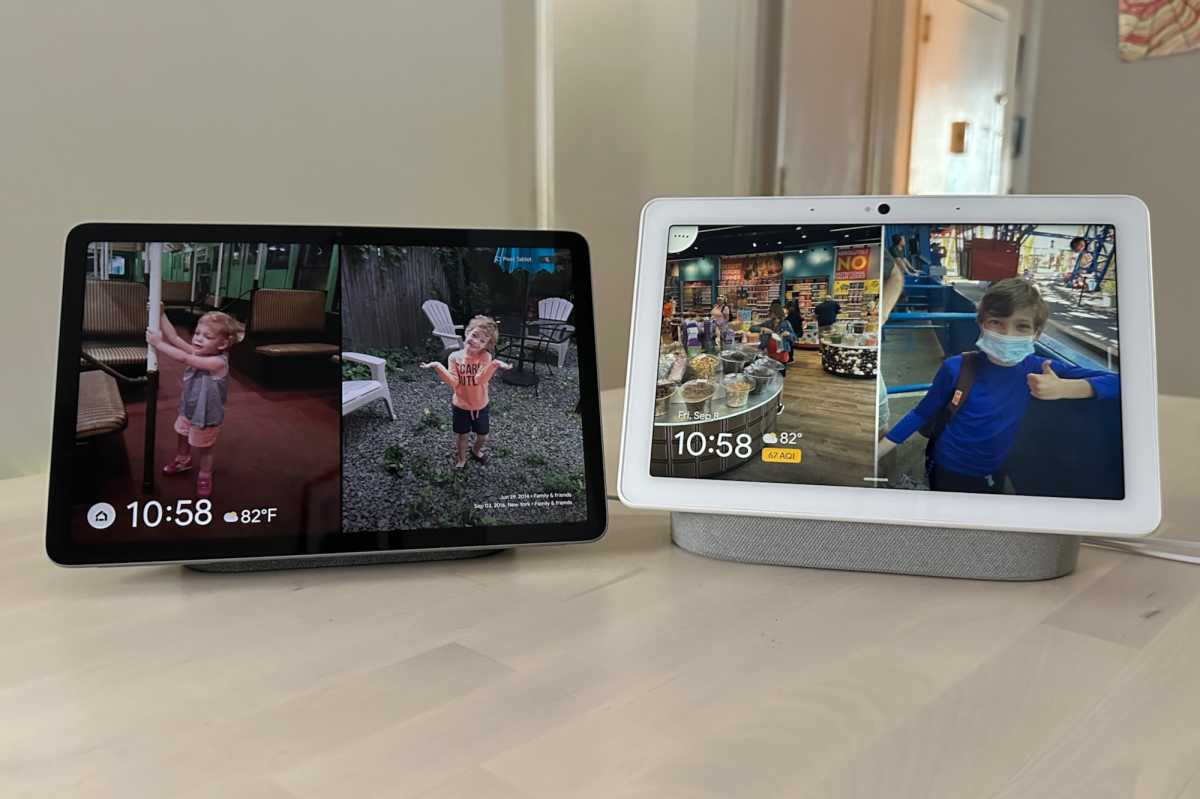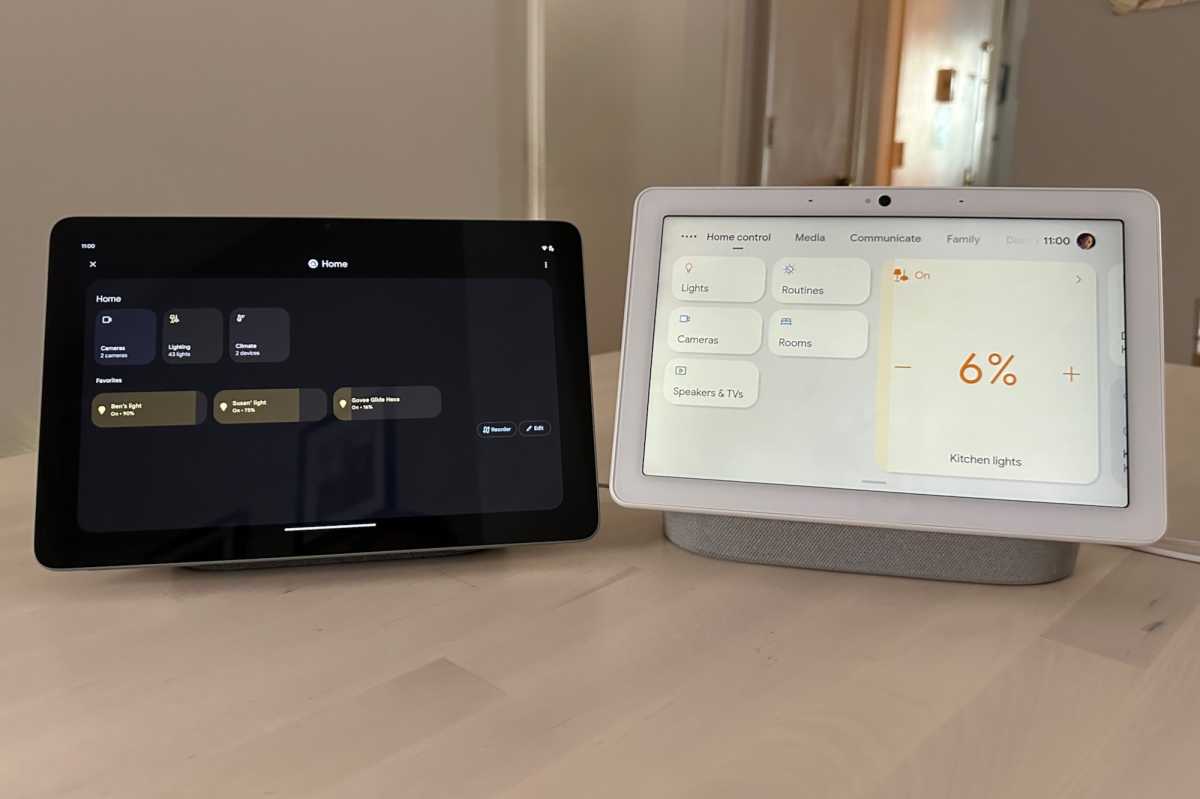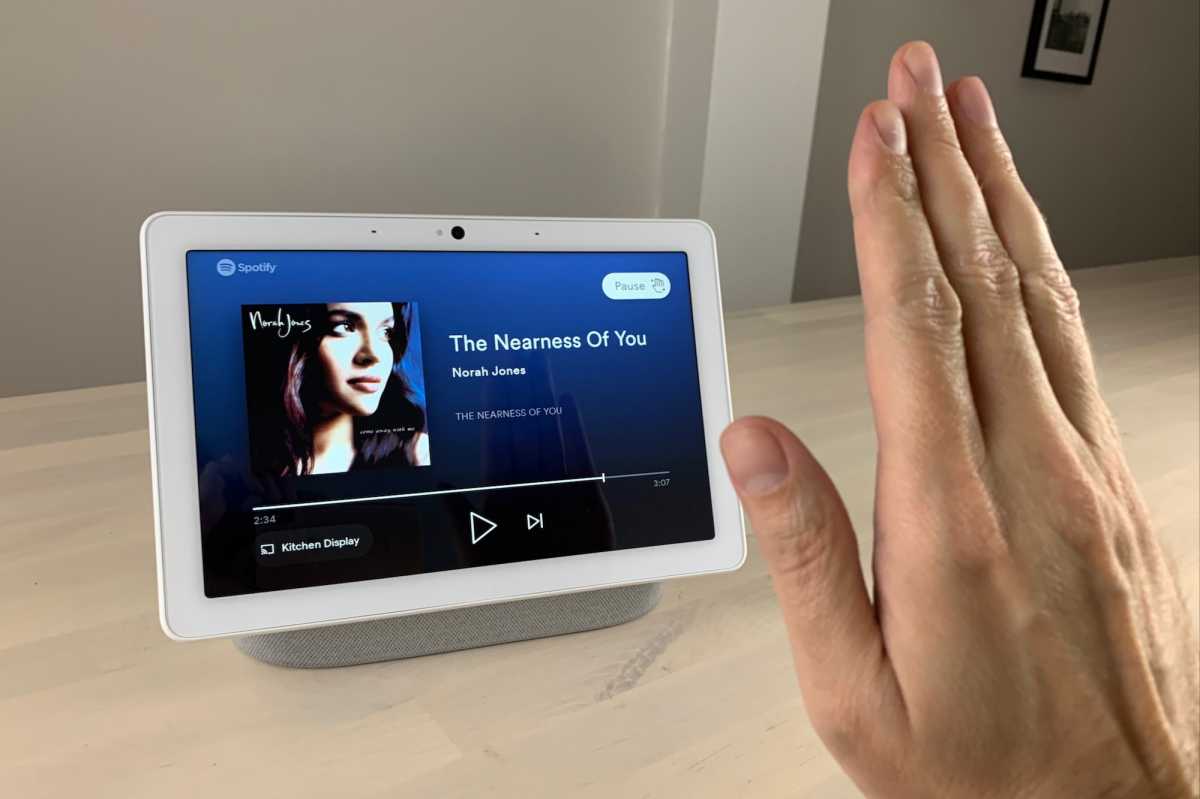Google doesn’t seem to be in any hurry to release a new version of its Nest Hub smart displays, but it has just unleashed a sleek new tablet that doubles as a smart display, making it a tempting choice for those leery of picking up an aging Nest Hub device.
On paper, the Google Pixel Tablet has it all: a gorgeous and roomy screen, a slim design, a bleeding-edge CPU, and a handsome magnetic dock that allows the tablet to display photos and act as a home hub when it’s not sitting in someone’s hands. Yes, it’s pricey, but the Google Pixel Tablet is a two-in-one type of device.
Then there’s Google’s two smart displays, the Nest Hub and the Nest Hub Max. The newest of the two displays, the second-generation Nest Hub, is now two years old, while the four-year-old Nest Hub Max is decidedly long in the tooth. Neither display is portable, nor are they particularly speedy, with their poky processors clearly showing their respective ages.
This feature is part of TechHive’s in-depth coverage of the best smart speakers and smart displays.
Sounds like the Google Pixel Tablet is a no-brainer over the Nest Hub or Nest Hub Max, right? Not so fast. While the Google Pixel Tablet is doubtless more powerful than Google’s older Nest Hub devices, the aging smart displays still have some aces up their sleeves that the Pixel Tablet can’t match.
So, what’s right for you, the Google Pixel Tablet or a Google Nest Hub display? Read on for our observations and buying advice.
Who should buy a Google Pixel Tablet?
Starting at $499, the Google Pixel Tablet is an Android-powered tablet with a twist: a fabric-covered dock with embedded magnets that hold the Pixel Tablet in place, allowing it to be used as a smart display when you’re not holding it.
In tablet mode, the Pixel Tablet works just as any other Android tablet would, letting you browse the web, check your Gmail, watch videos, play music, compose word documents, tinker with spreadsheets, and run thousands of Android apps.
In “hub mode,” the Pixel Tablet can act as a photo frame, showing a continuous slideshow of your favorite Google Photos snapshots. With Google Assistant on board, the Pixel Tablet can also respond to hands-free queries and voice commands, while a tap brings up a panel of touch-enabled smart home controls. Finally, the dock’s built-in speaker is perfect for playing tunes.
Google has pitched the Google Pixel Tablet as a tablet device that can make itself useful even when it’s not in someone’s hands. So if you’re an Android user who wants a versatile, portable device with extra smart-home functionality when it’s attached to its dock, the Pixel Tablet might be right for you.
Check out our sibling publication Tech Advisor for an in-depth Google Pixel Tablet review.
Who should buy a Google Nest Hub or Nest Hub Max?
While the Google Pixel Tablet is a jack of all trades, the Google Nest Hub ($99) and Google Nest Hub Max ($229) are much more specialized. Each display is designed primarily for taking charge of your smart home rather than acting as an all-purpose computing device.
Like the Google Pixel Tablet, both the Google Nest Hub and Google Nest Hub Max can display pictures from your Google Photos library when they’re not actively being used. But while the Pixel Tablet only offers a simplified control panel for your smart home devices, the two Nest Hub displays show much more elaborate smart controls, including (in the case of the larger Nest Hub Max) information that’s tailored to the person it sees.
The Nest Hub and Nest Hub Max also boast unique features like the ability to respond to your presence, or to hear suspicious sounds and even monitor the room they’re in.
So while the Nest Hub and (especially) the Nest Hub Max are saddled with older processors that slow down their performance, both displays are capable of smart-home tricks the Pixel Tablet can’t equal. That makes the Nest Hub displays good buys for users intent on giving their smart homes a boost.
Don’t miss TechHive’s in-depth Google Nest Hub review and Nest Hub Max review.
Which has the highest-resolution screen, the Google Pixel Tablet or the Google Nest Hub and Hub Max?
If pure screen resolution is one of the factors in your decision between the Pixel Tablet or a Nest Hub display, let’s end the suspense right here: The Pixel Tablet wins, by a landslide.
More specifically, the Pixel Tablet’s 10.95-inch display has a resolution of 2,560 x 1,600 pixels, that’s 276 pixels per square inch.
The Google Nest Hub Max, meanwhile, must make do with just 1,280 x 800 pixels on its 10-inch display. The smaller Nest Hub comes with a 7-inch display with a screen resolution of 1,024 x 600.
Winner: Google Pixel Tablet
Which is better as a digital photo frame, the Google Pixel Tablet or the Google Nest Hub and Hub Max?
It stands to reason that the device with the better screen resolution would make for a better digital photo frame, right? Let’s take a closer look.
The Pixel Tablet and the two Nest Hub displays have roughly the same features when it comes to photo frame functionality. Each can draw from images in your Google Photos library, including standard and “live” albums that are updated automatically with the latest snapshots of your loved ones. All three of the displays can also create complementary pairs of portrait photos, meaning you’ll never see unsightly blurry bars flanking taller, skinnier pictures.
Also, all three devices boast Google’s Ambient IQ technology, which intelligently adjusts the display brightness and colors to match the ambient light in the room.

The Google Pixel Tablet in photo frame mode on the left, with the Google Nest Hub Max on the right.
Ben Patterson/Foundry
When it comes to sheer image quality, the Google Pixel Tablet gets the edge over the two Nest Hubs. Besides its greater pixel density, the colors on the Pixel Tablet’s display look richer and more saturated.
On the other hand, the Pixel Tablet’s display looked a tad dark with Ambient IQ enabled in photo frame mode. The screen also looked like–well, a tablet screen. Sitting next to actual framed photos, the Pixel Tablet clearly looks like a digital device.
While the Nest Hub and Nest Hub Max don’t even come close to the Pixel Tablet’s pixel density, the pictures themselves looked a little brighter than they did on the tablet display (with Ambient IQ turned on in each case).
More importantly, the pictures on the Nest Hub and Nest Hub Max looked more natural, blending in nicely with their surroundings as well as nearby framed photos. Only the little digital clock and weather icons in the corner of the display betray the fact that you’re looking at a screen and not physical prints.
Opinions will likely differ on this point, but if you ask me, the Google Nest Hub and Nest Hub Max look better as digital photo frames than the Google Pixel Tablet does.
Winner: Google Nest Hub and Nest Hub Max
Which has the most processing power, the Google Pixel Tablet or the Google Nest Hub and Hub Max?
Again, I won’t belabor the obvious here: The Google Pixel Tablet’s processing power beats the pants off the puny CPUs in the Google Nest displays.
The Pixel Tablet comes packing Google’s Tensor G2, a system-on-a-chip with a total of eight cores (including two big cores, two medium cores, and four “little” cores) and an ARM Mali G710 MP07 graphics core, among other bells and whistles. The same processor that sits in Google’s Pixel 7 handsets, the Tensor G2 is a diminutive powerhouse that delivers silky smooth performance on the Pixel Tablet.
Now, the chips in the Google Nest Hub and Nest Hub Max are passable when it comes to powering smart displays. Both are quad-core CPUs with 1.9 GHz clock speeds, with the second-gen Nest Hub’s ARM processor adding a machine-learning hardware engine that makes it slightly faster at processing voice queries and answers.
Overall, though, the CPUs in both the Nest Hub and Nest Hub Max are older and way slower than the Pixel Tablet’s Tensor G2 chip, as you’ll notice as soon as you start noodling with the poky interfaces on both Nest Hub smart displays. They get the job done, but it’s not pretty.
Winner: Google Pixel Tablet
Which works better as a smart home control panel, the Google Pixel Tablet or the Google Nest Hub and Hub Max?
The Google Pixel Tablet might have the edge–a big one–in terms of processing power, but the Nest Hub and Nest Hub Max both have it beat as a control panel for your smart devices.
When it’s sitting on its dock, the Google Pixel Tablet has a small “home” button sitting in the corner of the screen; tap it, and you’ll get a series of smart home controls, including a handful of category tiles (including Cameras, Lighting, and Climate), as well as individual controls for a few “favorite” smart devices (you can edit and reorder your favorites).
Besides the Pixel Tablet’s smart home panel, you can also ask Google Assistant on the tablet to control your smart home devices–and you can do so hands-free, just as you could on a Nest Hub or a Nest smart speaker.
Nice, but when it comes to smart home, the Google Nest Hub and Nest Hub Max share a much more elaborate interface, complete with five tabs, including Your afternoon, Home control, Media, Communicate, Family, and Discover. The Your afternoon tab gives you a tiled summary of your day, while the Home control tab lets you access all the devices–and not just your favorites–in every “room” of your smart home. The Media and Communicate tabs let you dip into videos and initial video calls with your top contacts.

The Google Pixel Tablet (left) and Google Nest Hub Max showing their respective smart home controls.
Ben Patterson/Foundry
To be clear, the Pixel Tablet offers granular smart home controls, too (along with a wealth of media and communication options), but you’ll need to unlock the tablet and then navigate to the Google Home app to access those controls.
The Nest Hub and Nest Hub Max, on the other hand, don’t require you to unlock the screen for all your smart home controls; all you have to do is tap, and they’re at your fingertips.
Winner: Google Nest Hub and Nest Hub Max
Which is the most versatile, the Google Pixel Tablet or the Google Nest Hub and Hub Max?
While the Nest Hub and Nest Hub Max come with the most elaborate smart home interfaces, the Google Pixel Tablet doubtless wins for having the best all-around functionality.
Similar to an iPad, the Google Pixel Tablet does a little of everything. In addition to surfing the web or checking your Gmail, the Pixel Tablet offers apps for Google’s entire suite of online productivity tools–and if Google Docs and Sheets aren’t to your taste, you can always go with Microsoft Office.
The Pixel Tablet also has apps for YouTube and all the other big video-streaming services, not to mention YouTube Music, Spotify, and the like.
There’s also video conferencing via Google Meet, Zoom, and Skype, along with messaging, social networking, and the latest in mobile games.
The Google Nest Hub and Nest Hub Max offer some of the same tools and experiences as the Pixel Tablet, but only a small subset. For instance, you can stream Netflix on a Nest Hub or play Spotify tunes, and you can also dip into full-screen Google Meet and Zoom meetings.
But composing Word documents or playing Fortnite? Um, no, nor is there much in the way of social networking or messaging, aside from making Google Duo calls. And while the Nest Hub displays do have web browsers, they’re not good for much beyond displaying search results from a Google Assistant query.
Winner: Google Pixel Tablet
Which has the best smart home features, the Google Pixel Tablet or the Google Nest Hub and Hub Max?
We’ve already established that the Google Nest Hub and Hub Max make for better smart home control panels than the Google Pixel Tablet, but what about actual smart home features, such as smart hub functionality or smart sensors?
For starters, both the second-generation Google Nest Hub and Nest Hub Max can act as Thread border routers for Matter, the new and unifying smart home standard. With a Nest Hub or Nest Hub Max in the house, your Matter-enabled devices will be able to connect to each other as well as the internet, a feature that will become a bigger deal once Matter really gets off the ground.
Meanwhile, the Nest Hub Max has a built-in Nest camera, allowing it to monitor any room it’s in and warn you if something’s amiss while you’re away, as well as recognize who’s in the room so it can deliver personalized responses.
The Nest Hub lacks the Nest Hub Max’s Nest camera, but it does have a Soli chip, a miniature radar that can sense motion as well as track your sleep (if you let it).
Moving along, both Nest Hub devices can also listen for suspicious sounds such as smoke alarms and breaking glass, so long as you pony up for a Nest Aware subscription (starting at $8 a month). And both displays can recognize hand gestures (such as a palm out to pause your music), courtesy of the Nest Hub Max’s Nest cam and the Nest Hub’s Soli chip.

The Google Nest Hub and Nest Hub Max (pictured) can detect and respond to hand gestures.
Ben Patterson/Foundry
The Google Pixel Tablet, on the other hand, has none of those features–no smart hub, no Nest camera (it does have a camera for video calls), no motion-sensing Soli chip, and no ability to recognize suspicious sounds. The Pixel Tablet does have traditional tablet sensors such as an accelerometer and an ambient light sensor, but nothing that will aid it in smart home or home monitoring duties.
Winner: Google Nest Hub and Nest Hub Max
Which has the best audio quality, the Google Pixel Tablet or the Google Nest Hub and Hub Max?
Built into the Google Pixel Tablet’s magnetic dock is a 43.5mm full-range driver, while the tablet itself comes with four built-in speakers (which are disengaged when the dock’s speaker is active). But while music sounds relatively crisp from the Pixel Tablet’s dock speaker, bass is practically non-existent, resulting in a disappointingly tinny performance. You can always–and probably should–cast audio from the Pixel Tablet to another device via Chromecast.
The Nest Hub Max benefits from three drivers: two 18mm 10-watt tweeters, plus a 75mm 30-watt woofer, and combined, those speakers deliver surprisingly robust stereo audio, complete with a healthy dose of bass. To be clear, we still think the Nest Audio is the best-sounding of Google’s various Nest speakers, but the Nest Hub Max certainly holds its own, and to my ears, it sounds clearly superior to the Pixel Tablet’s speaker dock.
Similar to the Pixel Tablet’s dock, the Nest Hub has just a single 43.5mm driver, but it too sounds better than the tablet’s speaker dock, serving up full-bodied audio that doesn’t forget the bass.
Winner: Google Nest Hub and Nest Hub Max
Conclusion: Can the Google Pixel Tablet replace the Google Nest Hub and Nest Hub Max as a smart display?
There’s no doubt that the Google Pixel Tablet is a powerful piece of hardware, and with its included magnetic speaker dock, it’s unique among the various tablets we’ve tested over the years.
But while the Google Pixel Tablet packs some handy smart home features and acts like a smart display when it’s docked, it’s no replacement for the Google Nest Hub and Nest Hub Max. Aging though they are, Google’s smart displays offer a wealth of smart home controls, smart features (such as motion sensing and a Nest cam for the larger display), Thread radios, and impressive audio performance.
If you’re looking for a full-featured tablet that runs thousands of Android apps and offers bonus smart home functionality when it’s docked, the Google Pixel Tablet might be your first choice. But for Google smart home users who want a display-equipped smart hub, the Google Nest Hub and Nest Hub Max still reign supreme.

